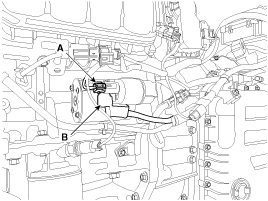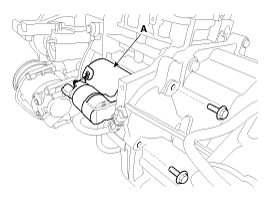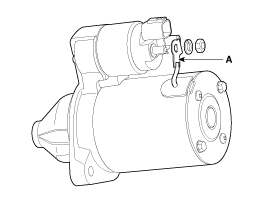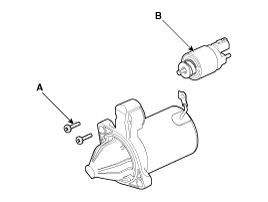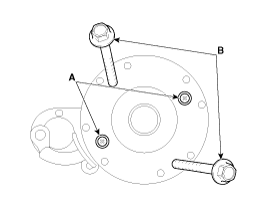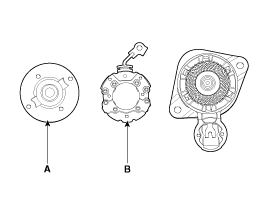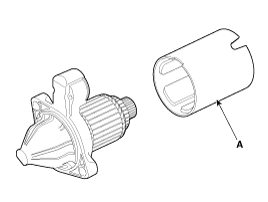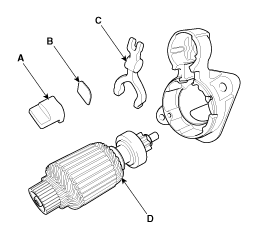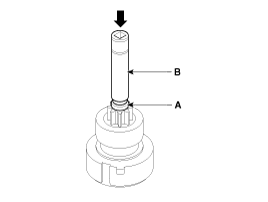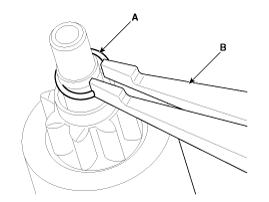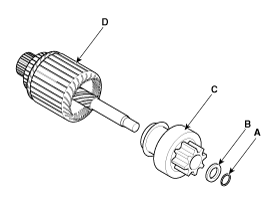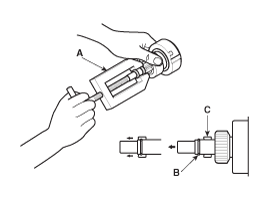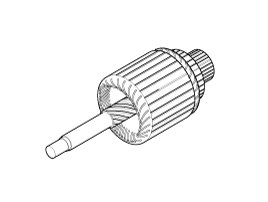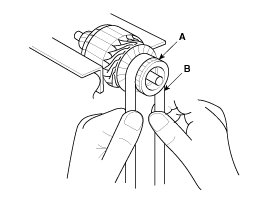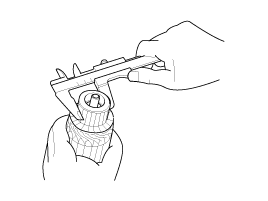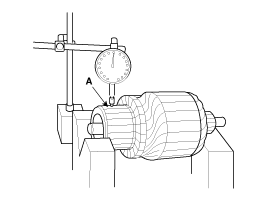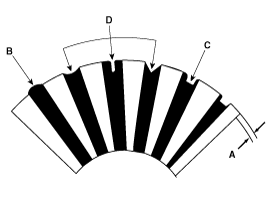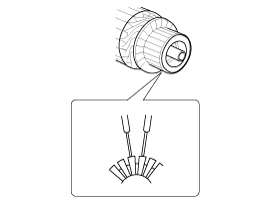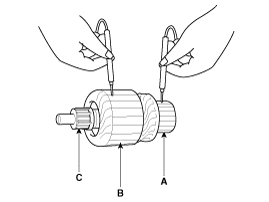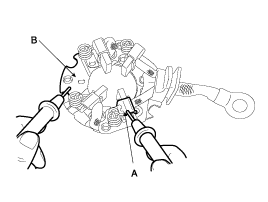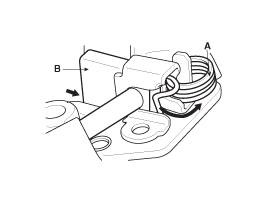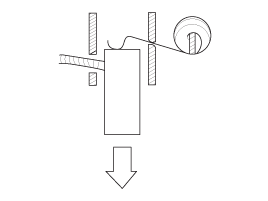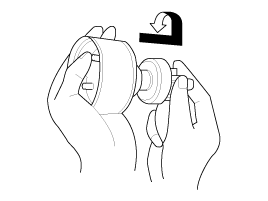 Hyundai Veloster: Starter
Hyundai Veloster: Starter
Repair procedures
Removal and Installation
| 1. |
Disconnect the battery negative terminal.
|
| 2. |
Remove the air duct and air cleaner assembly. (Refer to EM group)
|
| 3. |
Disconnect the starter cable (B) from the B terminal on the solenoid
then disconnect the connector (A) from the S terminal.
|
| 4. |
Remove the 2 bolts holding the starter, then remove the starter
(A).
|
| 5. |
Installation is the reverse of removal.
|
Disassembly
| 1. |
Disconnect the M-terminal (A) on the magnet switch assembly (B).
|
| 2. |
After loosening the 2 screws (A), detach the magnet switch assembly
(B).
|
| 3. |
Loosen the brush holder mounting screw (A) and through bolts (B).
|
| 4. |
Remove the rear bracket (A) and brush holder assembly (B).
|
| 5. |
Remove the yoke (A).
|
| 6. |
Remove the packing (A), lever plate (B), lever (C) and the armature
(D).
|
| 7. |
Press the stopper (A) using a socket (B).
|
| 8. |
Remove the stop ring (A) using stop ring pliers (B).
|
| 9. |
Remove the stop ring (B), stopper (A), overrunning clutch (C)
and armature (D).
|
| 10. |
Reassembly is the reverse of disassembly.
|
Inspection
| Armature Inspection And Test |
| 1. |
Remove the starter.
|
| 2. |
Disassemble the starter as shown at the beginning of this procedure.
|
| 3. |
Inspect the armature for wear or damage from contact with the
permanent magnet. If there is wear or damage, replace the armature.
|
| 4. |
Check the commutator (A) surface. If the surface is dirty or burnt,
resurface with emery cloth or a lathe within the following specifications,
or recondition with #500 or #600 sandpaper (B).
|
| 5. |
Check the commutator diameter. If the diameter is below the service
limit, replace the armature.
|
| 6. |
Measure the commutator (A) runout.
|
| 7. |
Check the mica depth (A). If the mica is too high (B), undercut
the mica with a hacksaw blade to the proper depth. Cut away all the
mica (C) between the commutator segments. The undercut should not be
too shallow, too narrow, or v-shaped (D).
|
| 8. |
Check for continuity between the segments of the commutator. If
an open circuit exists between any segments, replace the armature.
|
| 9. |
Check with an ohmmeter that no continuity exists between the commutator
(A) and armature coil core (B), and between the commutator and armature
shaft (C). If continuity exists, replace the armature.
|
Inspect Starter Brush
Bruch length
Standard : 12.3 mm (0.4843 in)
Service limit : 5.5 mm (0.2165 in)
|
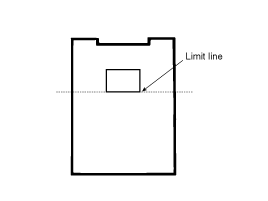
Starter Brush Holder Test
| 1. |
Make sure there is no continuity between the (+) brush holder
(A) and (-) plate (B). If there is continuity, replace the brush holder
assembly.
|
| 2. |
Pry back each brush spring (A) with a screwdriver, then position
the brush (B) about halfway out of its holder, and release the spring
to hold it there.
|
| 3. |
Install the armature in the housing, and install the brush holder.
Next, pry back each brush spring again, and push the brush down until
it seats against the commutator, then release the spring against the
end of the brush.
|
Overrunning Clutch
| 1. |
Slide the overrunning clutch along the shaft.
Replace it if does not slide smoothly.
|
| 2. |
Rotate the overrunning clutch both ways.
Does it lock in one direction and rotate smoothly in reverse?
If it does not lock in either direction or it locks in both directions,
replace it.
|
| 3. |
If the starter drive gear is worn or damaged, replace the overrunning
clutch assembly. (the gear is not available separately).
Check the condition of the flywheel or torque converter ring gear
if the starter drive gear teeth are damaged.
|
Cleaning
| 1. |
Do not immerse parts in cleaning solvent. Immersing the yoke assembly
and/or armature will damage the insulation. Wipe these parts with a
cloth only.
|
| 2. |
Do not immerse the drive unit in cleaning solvent. The overrun
clutch is pre-lubricated at the factory and solvent will wash lubrication
from the clutch.
|
| 3. |
The drive unit may be cleaned with a brush moistened with cleaning
solvent and wiped dry with a cloth.
|
 Starter
Starter
Components and Components Location
Components
1. Screw
2. Front bracket
3. Stop ring
4. Stopper
5. Overrun clutch
6. Lever
7. Lever plate
8. Lever packing
9. ...
 Starter Relay
Starter Relay
Repair procedures
Inspection
1.
Remove the fuse box cover.
2.
Remove the starter relay (A).
3.
...
See also:
Automatic turn off function
The interior lights automatically turn off approximately 20 minutes after the
ignition switch is turned off.
If your vehicle is equipped with the theft alarm system, the interior lights
automatic ...
Description and Operation
Operation and Leakage Check
Check all of the following items:
Component
Procedure
Brake Booster (A)
Check brake operation by applyin ...
Changing a tire with TPMS
If you have a flat tire, the Low Tire Pressure will come on. Have the flat tire
repaired by an authorized HYUNDAI dealer as soon as possible or replace the flat
tire with the spare tire.
CAUTION
...
Categories
- Hyundai Veloster Manuals Home
- Hyundai Veloster 2010-2017 Owner's Manual
- Hyundai Veloster 2010-2017 Service Manual

